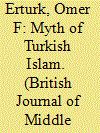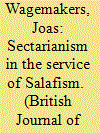|
|
|
Sort Order |
|
|
|
Items / Page
|
|
|
|
|
|
|
| Srl | Item |
| 1 |
ID:
184468


|
|
|
|
|
| Summary/Abstract |
Shahab Ahmed’s What is Islam?: The Importance of Being Islamic, published in 2016, has significantly impacted discussions on the definition of Islam. This article focuses on Ahmed’s reconceptualization of Islam as ‘hermeneutical engagement with Pre-Text, Text, and Con-Text of Revelation to Muḥammad’. As an Islamic tradition which greatly contradicts various normative Islamic traditions, Alevism is a valuable locus for testing Ahmed’s reconceptualization of Islam. In the first part of this article, I aim to show how Alevis formulated their relation to Islam in their poetry and other classical texts, in order to address whether we can situate Alevism within the sphere of Islam as defined by Shahab Ahmed. In the second part, I compare Ahmed’s conceptualization of Islam to those of Alevis. For both parts, I use as my source the historical and literary documents of Alevism, such as buyruḳs, mathnawīs, dīvāns, and poems in poetry collections. I argue that including cases like Alevism to Islam’s landscape of contradictions (limited to Sunni Islam in Ahmed’s work) not only deconstructs our (in this case, Ahmed’s) existing conceptualizations of Islam, but also serves to reconceptualize Islam.
|
|
|
|
|
|
|
|
|
|
|
|
|
|
|
|
| 2 |
ID:
184466


|
|
|
|
|
| Summary/Abstract |
The spike in the number of Arabic writings on the nahḍah since the beginning of the 1990 s represents a new and intriguing development in contemporary Arab thought. This relatively recent nahḍah-frenzy is best reflected in the new editions, collections and re-publications of nahdawi writers whose articles and essays remained, until recently, scattered and dispersed. Why did the 1990 s mark a time where the need to repackage of Nahda literature became urgent? This article argues that only through contextualizing the question of nahḍah within the growing Arab debate on turath, this question finds its resolution. Offering to dissect the debate on turath, explicating the motives that stood behind its propounders, and the cultural sensibilities its gave rise to, affords a vantage point through which to explain the obsession with nahḍah in the post-colonial Arab world.
|
|
|
|
|
|
|
|
|
|
|
|
|
|
|
|
| 3 |
ID:
184471


|
|
|
|
|
| Summary/Abstract |
Despite the official secularity of the Syrian state, religion has always been a viable instrument used by the Baˈathist regime to consolidate its authority and legitimacy. Taking different historical trajectories ranging from confrontation to co-optation, the boundaries between state and religion have shifted to conflation in the post-2011 uprising. The official political rhetoric has become explicitly religious and anti-secular, ending an era of official secularity since the 1970s. This newly employed religious rhetoric is evident in the presidential discourse, which is heavily and explicitly infused with religious language. Analysis of Bashar al-Assad’s speech to high-ranking ulama in 2011 and his other public statements on the website of the Ministry of Awqaf provides evidence not only of how such religious language marks the move from secularity, which was used to strategically co-opt religious institutions up to 2010, but also how the deployment of religion has become a source of security, legitimacy and survival for the Baˈathist regime since 2011.
|
|
|
|
|
|
|
|
|
|
|
|
|
|
|
|
| 4 |
ID:
184464


|
|
|
|
|
| Summary/Abstract |
Turkish Islam has been defined as unique and exceptional, and it is suggested that it is an antidote to radical Islamic ideologies due to its adherence to the supposedly moderate and rational Hanafi-Maturidi theology, which is considered to have an inclusive and tolerant Sufi character. Turkish Islam is mostly defined by its Gümüşhanevi lineage, the most successful, though not theologically heterogeneous, of all active Naqshbandi communities in Turkey. Sharing a belief in its non-revolutionary character, some have asserted that it is open to democratic values. This study delves into the concept of ‘Turkish Islam’ in the belief that there is a lack of in-depth textual and methodological analysis to assess these claims. Based on a text-based analysis of primary sources, particularly the works of Ahmed Ziyaeddin Gümüşhanevi and Mehmed Zahid Kotku, two leading masters of the Naqshbandi-Gümüşhanevi discipline, this study uncovers the foundational religious motivation and codes behind Turkish Islam. As a research methodology, content analysis with purposive sampling was conducted, focusing on six of the most defining issues of Islam, al-wala’ wal-bara’, apostasy, jihad, the Islamic state, women, and art and philosophy. The study concludes that Turkish Islam is not unique or even exceptional either at the theological and discursive levels, nor does it necessarily demonstrate a willingness to embrace the values attributed to it.
|
|
|
|
|
|
|
|
|
|
|
|
|
|
|
|
| 5 |
ID:
184463


|
|
|
|
|
| Summary/Abstract |
This article aims to shed light on two principle subjects relating to language and culture in the Jewish community in Palestine before the rise of Zionism. First, it attempts to describe and to deepen our understanding of the Yiddish of the Ashkenazi community spoken in Historical Palestine in the 18th and 19th centuries. This dialect of Yiddish, referred to in this article as ‘Palestinian Yiddish’, was permeated with Arabic influences. Secondly, and in conjunction with addressing this dialect, the article explores various facets of the knowledge of Arabic among the Ashkenazi community in the country. In this respect, it highlights that the increased knowledge of Arabic in the Ashkenazi community indicates not only acquaintance with the language itself, but also encompasses broader insights about the relations between the Ashkenazi community and the Arab-Palestinian people which challenges the traditional research on the topic. Based on socio-linguistic analysis, as well as inslights from language contact and language and society, this article claims that the language parameter can highlight the social and political routes in which the Ashkenazi Palestinian community was paving, including those of acclimation, integration and being part of the general hegemonic Arab culture. As I argue, this is not unconnected to Zionism’s strenuous recoil from both of these languages—Yiddish and Arabic. ‘Palestinian Yiddish’ and ‘Ashkenazi Arabic’, therefore, jointly reveal a period as it once was and is no more: language skills and social relations that posed a threat to separatist practices that were to be pushed forward by the Zionist movement.
|
|
|
|
|
|
|
|
|
|
|
|
|
|
|
|
| 6 |
ID:
184467


|
|
|
|
|
| Summary/Abstract |
Who are the most notable and successful political leaders in the Middle East? Employing the concept of political time and through a survey of textbooks and popular history books relating to the region, 22 prominent individuals are identified in the modern period (i.e. since 1800). All were male and half of them came from the regional core (i.e. Egypt and the Mashreq countries). The leaders mainly came from the establishment and the armed forces. They mostly exercised power during the second half of the twentieth century. Many of them governed for long periods of time. Half of them were forcibly removed from office. The reasons for their removal were for political rather than economic reasons; there was little difference in economic performance between leaders who were forcibly removed and those who were not. However, one distinction between the two types of leaders was over their level of public spending. Those who kept government spending over 20% of GDP were less at risk. Ultimately, what made a political leader successful involved the following: an ability to act independently; avoiding forcible removal from office; and his political regime surviving his departure.
|
|
|
|
|
|
|
|
|
|
|
|
|
|
|
|
| 7 |
ID:
184465


|
|
|
|
|
| Summary/Abstract |
For many decades, cultural representations of the military and military service in Israel, particularly in films and television series, tended to focus on male Sabra (Israeli-born) soldiers and their combat experiences, portraying them from either a ‘heroic-nationalist’ or a ‘post-heroic’ perspective. However, several recent Israeli films and television series bring to the fore men and women from different social backgrounds who serve as non-combatant soldiers (jobniks) far behind the frontlines. Such depictions of ‘anti-heroic’ soldiers expose previously underrepresented aspects of service in the Israeli military, ranging from subtle expressions of a lack of motivation to open acts of resistance. Based on an analysis of several notable films and television series featuring jobnik protagonists, we argue that although these works give voice to previously underrepresented social groups and accord legitimacy to soldiers’ acts of resistance, they simultaneously foster a more conservative discourse regarding military service in Israel by excluding other social groups and setting limits on individuals’ conduct within and outside the military. These findings suggest that while popular culture can challenge militarist tendencies, it may ultimately reinforce the military’s position as the ‘people’s army’ and the social norm of mandatory conscription.
|
|
|
|
|
|
|
|
|
|
|
|
|
|
|
|
| 8 |
ID:
184470


|
|
|
|
|
| Summary/Abstract |
Jordanian Salafis are often anti-Shiite and employ the religious and conspiratorial arguments against Shiism found among Salafis elsewhere. Yet the specific arguments they use show that they are not merely the Jordanian exponents of a global anti-Shiite Salafi trend, but also have reasons of their own to exploit sectarianism. These reasons have to do with the near absence of Shiite communities in Jordan (meaning that anti-Shiite sentiments will not lead to civil strife in Jordanian society itself), the regime’s ecumenical attitude towards Twelver and Fiver Shiites and its highly critical views of ‘political Shiism’ and ‘Shiitizers’. At the same time, the position of Salafis in Jordan, whose beliefs are viewed with scepticism by a regime that supports ‘moderate’ Islam, also plays a role. Quietist Salafis, who shun political activism, are keen to show the regime their non-violent, obedient and loyalist credentials as allies in the fight against radical Islamism. Political Salafis, who do engage in political activism, also want to show that there is nothing to fear from them and that they can be trusted. Both groups have used Shiism to make these points, showing that Salafi anti-Shiism is not just a global phenomenon, but is also locally shaped.
|
|
|
|
|
|
|
|
|
|
|
|
|
|
|
|
| 9 |
ID:
184469


|
|
|
|
|
| Summary/Abstract |
This study examines citizens’ sense of neighbourhood belonging in the Gulf Cooperation Council (GCC) countries, focusing on the State of Qatar. While much research about this issue has been conducted in developed countries, little is known about how citizens’ ‘stock’ of social capital, religiosity and civic engagement affect their sense of belonging to their neighbourhood within GCC countries. In the present study, we address this question by analysing data from two waves of nationally representative surveys undertaken in Qatar, drilling down into the various dimensions of social capital and their effect on community attachment at the neighbourhood level. The results indicate that, even after controlling for a wide range of demographic variables, social capital has a strong effect on the nationals’ sense of belonging to their communities. The results have implications for researchers with respect to the salience of social capital as a concept and for policymakers concerned with building an integrated and diverse community that is inclusive of people from various backgrounds.
|
|
|
|
|
|
|
|
|
|
|
|
|
|
|
|
| 10 |
ID:
184462


|
|
|
|
|
| Summary/Abstract |
This article traces the Egyptian Muslim Brotherhood’s trajectories in the aftermath of 2013 up to 2018, focusing on the main challenges that the movement faces when trying to react to its perceived failure and ongoing repression. Following the coup, the Brotherhood entered a state of stagnation that is currently struggling to break out from. With most of its historical leadership either abroad or in jail, the Brotherhood is splintering into different factions and therefore lacks a coherent strategy vìs-a-vìs the regime and a cohesive sense of identity. Similarly, the organization’s removal from Egypt’s socio-political life—coupled with the unprecedented intensity of state repression- mean that the Brotherhood needs to develop new ways to survive illegality and stagnation. This article argues that, under such unfamiliar circumstances, the movement is growing increasingly divided by tensions between stagnation and adaptation strategies. This is manifested in the disconnect between the Brotherhood organization’s response to repression and that of its members. Drawing from ethnographic fieldwork conducted in Turkey and the UK between 2013 and 2018, with both current and former members, the paper shows that the Brotherhood’s fragmentation is driven by tensions between historical stances and desires to adapt to its current situation.
|
|
|
|
|
|
|
|
|
|
|
|
|
|
|
|
|
|
|
|
|